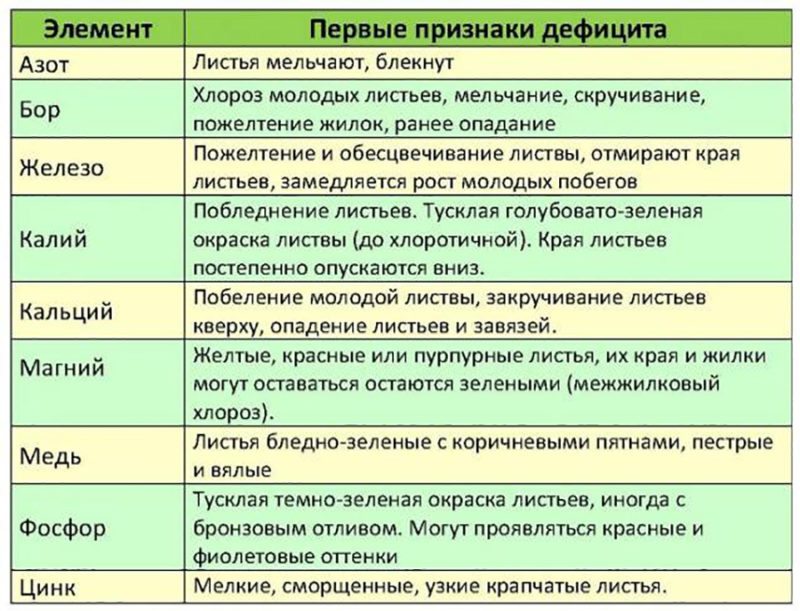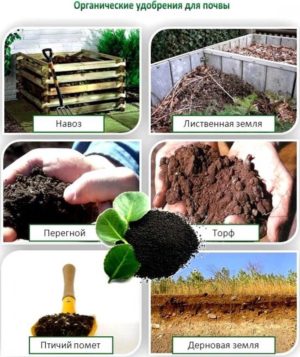Fertilizing the garden correctly: how to feed an apple tree in July for a good harvest
Yellow, red, green - what kind of apples do not grow in Russian gardens. Juices and compotes are made from aromatic fruits, preserves and jams are made. In order for the harvest to be rich and tasty, in July, summer residents feed the trees with root and foliar fertilizers. They accelerate fruit ripening and increase yields. What exactly to feed the apple tree in July, we will consider in the article.
The content of the article
- Do apple trees need feeding in July
- What fertilizing does an apple tree need in July
- When to feed an apple tree in July
- Fertilization frequency and abundance
- How to feed
- How to fertilize old apple trees / young / seedlings
- The choice of feeding in the middle lane
- How to feed apple trees
- Experienced gardening tips
- Conclusion
Do apple trees need feeding in July
Apple trees are fed throughout the summer... In July, apples are filled with juice, so gardeners pay attention to mineral fertilizers. They stimulate the development of fruits, affect their taste and keeping quality.
If you do not feed the apple tree in July, the yield will decrease. And the apples themselves will not be so sweet and juicy. If for some reason it is impossible to feed the tree in July, it is recommended to do it in June - to apply complex fertilizers.
What fertilizing does an apple tree need in July
Summer residents pay special attention to mineral and organic fertilizing based on phosphorus, potassium and other trace elements. The lack of even one of them leads to a weakening of the immune system and disease.
Substance deficiency symptoms
If the apple tree lacks nitrogen, the shoots dry out and break, the leaves become thinner and turn green. The first symptoms of a deficiency are visible on old leaves. The plant weakens, metabolism is disturbed, the apple tree reduces yield. In this case, it is recommended to devote time to organic fertilizers based on manure, compost or peat.
With a lack of phosphorus on leaves appear bronze tint, the fruits become smaller, grow soft and shapeless. If the apple tree lacks calcium, the leaves curl and fall off, the yield decreases.
Gardeners often face the problem of a lack of copper - dark spots appear on the leaf plate. Often a deficiency of trace elements is expressed in the form of diseases - the apple tree is affected by fruit rot or powdery mildew.
Attention! An excess of calcium in the soil leads to the fact that the plant does not absorb magnesium and potassium poorly, which causes the apples to crack. Top dressing should be balanced.
When to feed an apple tree in July
When choosing a day, gardeners take into account the weather conditions. A good time to feed is early morning on a cloudy and dry day. Do not fertilize the tree in hot or rainy weather, in strong winds. You can also apply fertilizer in the evening, after sunset or near it. Otherwise, the plant has a high risk of getting chemical burns, which are formed when substances come into contact with heated stems, branches and roots.
Fertilization frequency and abundance
An interval of 3-4 weeks is observed between fertilization. If you do this more often, top dressing will harm the apple tree more than it will benefit.
The abundance depends on the state of the tree, how old it is. For example, if the apple tree is young, they focus on nitrogen, phosphorus and potash fertilizers; make 20-30 g per 1 sq. m. If the tree is sick, pay attention to chemicals. The consumption of each product is indicated on the package.
How to feed
Top dressing in summer can be mineral or organic, purchased or homemade. Sometimes gardeners alternate them with each other: at the beginning of July, they make a composition based on folk recipes, at the end they add the finished one.
Mineral fertilizers
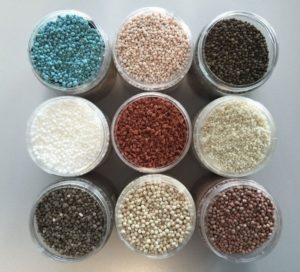
The Nutrisol Lux mineral fertilizer is suitable for summer feeding. It contains nitrogen, potassium and phosphorus, which increase the plant's resistance to external conditions and improve yields.
"Nutrisol Lux" is quickly absorbed and harmless to the environment. Sold in granules that dissolve easily in water.
The complex is used 3-4 times per season, including feeding during fruiting. Dissolve 25 g of the substance in 10 liters of water, stir with a wooden stick and bring under the root through the prepared grooves.
Effective in use and fertilizer "Rostmoment"... Universal feeding accelerates the development of fruits, increases frost and drought resistance of trees. The dilution rate is 15 g per 10 ml of water. One tree takes 2-7 liters, depending on the age of the tree. Before use, it is recommended to loosen the soil, remove all weeds and fallen leaves.
Attention! In July, fertilizing from 50 g of nitrophoska and 5 g of sodium humate in the form of dry matter is useful. They are dissolved in 10 liters of water and brought under the tree. The fertilizer is involved in carbohydrate metabolism, improves the taste and marketability of apples.
Organic compounds
The apple tree is fertilized with infusion of bird droppings... It contains magnesium, potassium, calcium, phosphorus, iron. Litter is used for soil of any composition and acidity. It is enough to feed the tree once every 2 years.
In a plastic barrel, the droppings are mixed with water in a 1: 1 ratio, covered with a lid and left for 2-3 weeks. Before use, the solution is diluted with water in a 1: 5 ratio and watered with an apple tree. During the procedure, make sure that the liquid does not get on the branches, fruits and leaves.
To increase the fertility and air permeability of the soil, a layer of sawdust is laid around the trunk. They serve not only as a fertilizer, but also as a mulching layer.
To enhance the effect, they are moistened with slurry and mixed with tree bark. This method protects the roots and trunk from pests, increases productivity.
Folk remedies
Folk fertilizers are intended not only for plant nutrition, but also as protection against diseases and pests.
For spraying apple trees, a mustard solution is used. 10 g of dry powder is poured into 10 liters of water and infused for 2 days. After filtering and add 50 g of grated laundry soap. Spray the whole tree in the morning or evening.
Fertilize fruit trees with wood ash. It contains nitrogen, calcium, magnesium, phosphorus, iron. Ash lowers the acidity of the soil, enriches it with microelements. For 1 sq. m requires 1 tbsp. Ash is scattered at a distance of 5 cm from the trunk, having previously drilled out the soil. During the season, feeding is applied 2-3 times with an interval of 4 weeks.
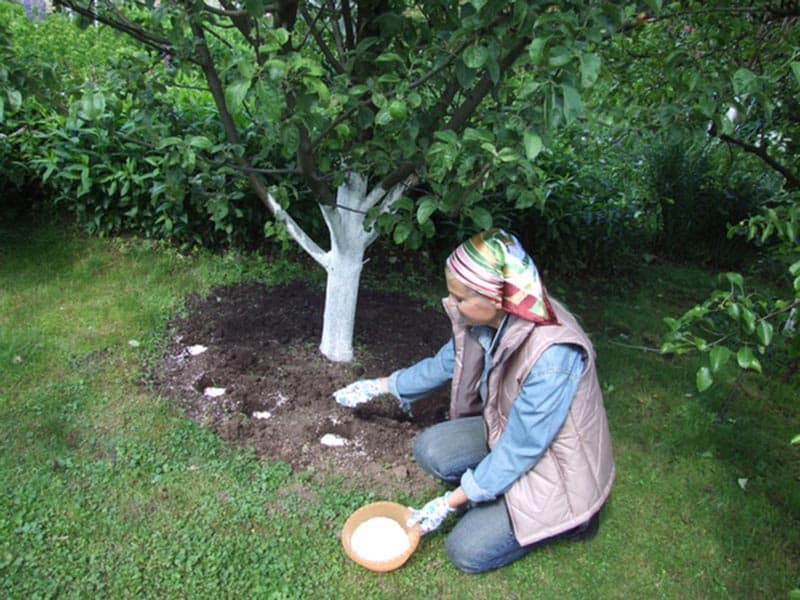
How to fertilize old apple trees / young / seedlings
It is recommended to feed the old apple tree with boric solution. It increases resistance to diseases and pests, is quickly absorbed, and strengthens the immune system. In 10 liters of pure water, 20 g of boric acid are diluted and the resulting composition is sprayed on the tree. Also during this period, ready-made complex fertilizers are used - they are aimed at stimulating fruiting. Gardeners recommend using Agromaster.
Young trees love phosphorus and potassium, so summer residents fertilize them with double superphosphate, monophosphate or potassium sulfate. They are introduced in liquid form by dissolving 10 g of the substance in 5 liters of water. The agent is not brought under the trunk, but 50 cm away from it. Before the procedure, the apple tree is watered abundantly with warm water - this will improve the absorption of trace elements and protect young roots from burns.
Attention! If the top dressing still gets on the leaves and branches, summer residents wash them with clean water using sprinkling. It is convenient to do this from a spray bottle.
The seedlings are not fertilized after planting for 2-3 years. They get all the nutrients from the planting pit. Before planting, gardeners bring into it a composition of equal parts of compost, rotted manure, peat and humus.
Top dressing during fruiting / ovary formation / after flowering
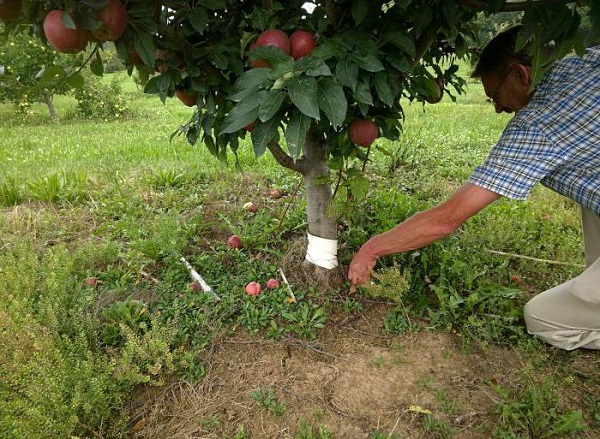
During fruiting, foliar feeding with the "Plantafid" preparation is effective. It is completely soluble in water, undemanding to storage conditions. In addition to the main trace elements, it contains sulfur, molybdenum, manganese, and zinc. "Plantafid" complements root dressing and protects the apple tree from adverse weather conditions.
During the formation of ovaries, the apple tree is sprayed with a urea solution - 20 g per 10 l of water. With its help, the apple tree delays flowering and thereby reduces the likelihood of ovary shedding. The procedure also protects the tree from pathogens and insects.
After flowering, a popular organic fertilizer is applied - bone meal. It is safe for humans and soil, decomposes within 3 years, and is easy to prepare. Bone meal is scattered over the surface of the earth in an even layer, per 1 sq. m spend 50 g.
The choice of feeding in the middle lane
In the middle lane, apple trees respond well to the alternation of mineral and organic fertilizing. Early July landing fertilized with the Agromaster complex, and after 3-4 weeks sprayed with an ash solution.
It is important to remember about watering and loosening between procedures - this will help the fertilizers to be absorbed faster. Their competent alternation will strengthen the immunity of the tree and protect it from external factors.
In the Urals
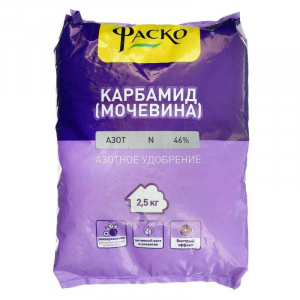
In the Urals, attention is paid to fertilizers that will protect the apple tree from diseases and pests. These are foliar feeding with a solution of ash or urea, as well as root fertilizers based on superphosphate. For preparation, 40 g of superphosphate is required to be diluted in 10 liters of water. The solution is poured into the grooves, after which they are covered with loose earth.
In Siberia and other regions
During the entire growing period, fertilizer is applied under the tree, which will protect the apple tree from frost, winds and other unforeseen weather conditions.
The "Gumi-Omi" preparation for fruit trees contains sodium humates, macro- and microelements, boron and copper. Under each apple tree add 100 g of the substance, for the preparation of liquid feeding, 100 g of "Gumi-Omi" is dissolved in 10 liters of water.
How to feed apple trees
The apple tree is fed by root and foliar (by leaves) methods. It is recommended to alternate them with each other.
Root way

Mineral and organic fertilizers are embedded in grooves located at a distance of 50-70 cm from the trunk. Before the procedure, the soil is loosened, weeds, fallen leaves and fruits are removed. It is also recommended to water the apple tree abundantly.
The following are used as root fertilizers:
- chicken manure solution;
- urea;
- ammonium nitrate;
- wood ash;
- superphosphate.
Foliar
Foliar dressing is spraying the apple tree. They are carried out in dry and calm weather at a temperature not higher than + 25 ° C. Often, such procedures are combined with spraying the apple tree against diseases and insect pests.
Summer residents use:
- boric acid solution;
- nettle;
- mullein;
- diammophoski;
- potassium nitrate.
Experienced gardening tips
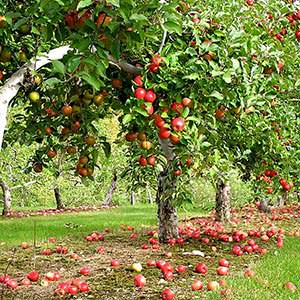
To speed up the ripening of apples and get a rich harvest, experienced gardeners recommend following simple rules:
- buy complex fertilizers in trusted stores, monitor the expiration date of drugs;
- prepare working solutions in accordance with the dosage;
- do not feed the apple tree more than 2 times a month;
- use clean dishes and garden tools to prepare solutions;
- do not apply fertilizer at noon when the bright sun is shining;
- regularly inspect apple trees for symptoms of micronutrient deficiency;
- do not forget about watering, loosening, weeding and mulching the soil.
Conclusion
The apple tree responds well to liquid and dry dressings. Gardeners use urea, superphosphate, ash, chicken droppings, boric acid.Fertilizers are applied in the morning or evening to wet and loose soil. Follow the feeding scheme, according to which 1 sq. m leaves on average 20-40 g of active ingredient.
A balanced diet accelerates the development of fruits and protects the crop from diseases and pests.
